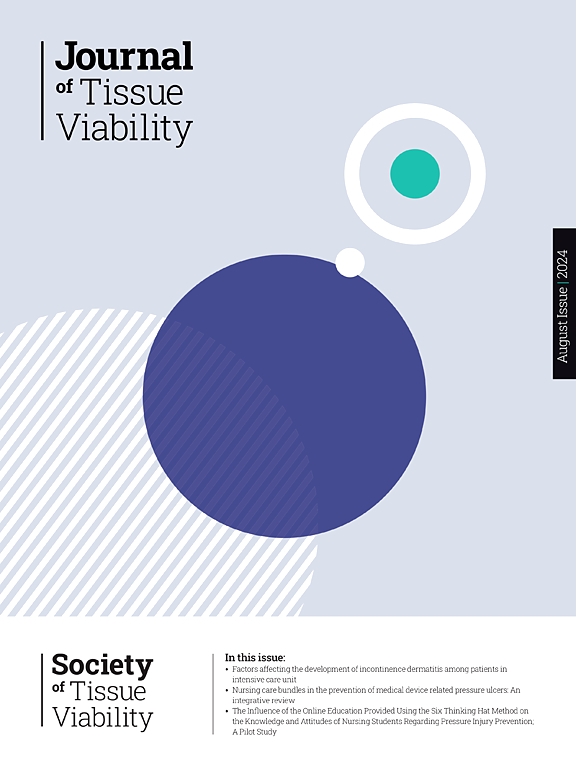医院护士对尿失禁相关性皮炎的知识、态度和做法的模式分析
IF 2.4
3区 医学
Q2 DERMATOLOGY
引用次数: 0
摘要
目的分析医院护士对尿失禁相关性皮炎(KAP-IAD)的知识、态度和行为。方法本研究采用医院护士对失禁相关性皮炎的知识、态度和实践问卷(KAP-IAD-Q)进行问卷调查。采用主成分层次聚类(HCPC)、k均值聚类(K-means)和围绕介质划分(PAM)三种聚类方法分析了KAP-IAD的相关性。一种分类方法被用来解释这些相关性背后的潜在行为模式。结果两个聚类最合适。使用HCPC、K-means和PAM三种聚类方法为KAP-IAD数据生成决策属性(D)。生成带有分类标签的3个数据集,利用粗糙集(RS)方法对每个数据集建立预测模型和决策规则。在三个数据集中,PAM方法的准确率最高。经过5轮随机建模,共生成57条决策规则。此外,正如领域专家所讨论的那样,支持阈值为50或更多的模式或规则被认为是主要的行为或规则。结论我们的研究为KAP-IAD护理实践提供了明确的决策规则,这是以往研究缺乏的。确定的关键变量和规则可作为KAP-IAD护理实践的指导,以及在护理实践中认识KAP-IAD相关皮炎的病因、危险因素和关键影响因素。本研究为预防和治疗尿失禁相关性皮炎提供了重要的管理方法。本文章由计算机程序翻译,如有差异,请以英文原文为准。
Pattern analysis of hospital nurses' knowledge, attitudes, and practices regarding incontinence-associated dermatitis
Purpose
To analyze hospital nurses' knowledge, attitudes, and practices regarding incontinence-associated dermatitis (KAP-IAD).
Methods
This study utilized responses from hospital nurses to the Knowledge, Attitudes, and Practices of Incontinence-Associated Dermatitis Questionnaire (KAP-IAD-Q). Three clustering methods, Hierarchical Clustering on Principal Components (HCPC), K-means, and Partitioning Around Medoids (PAM), were applied to analyze the correlations of KAP-IAD. A classification method was used to explain the underlying behavioral patterns behind these correlations.
Results
Two clusters were found to be most appropriate. Decision attributes (D) were generated for the KAP-IAD data using the three clustering methods: HCPC, K-means, and PAM. Three datasets with categorical labels were generated, and predictive models and decision rules were established for each dataset using the Rough Set (RS) method. The PAM method demonstrated the highest accuracy among the three datasets. After five rounds of stochastic modeling, 57 decision rules were generated. Additionally, patterns or rules with a support threshold of 50 or more, as discussed by domain experts, were considered the primary behaviors or rules.
Conclusions
Our study suggests clear decision rules for KAP-IAD nursing practice, which have been absent in previous research. The key variables and rules identified can serve as a guide for KAP-IAD nursing practice, as well as for recognizing the etiology, risk factors, and key influences of dermatitis associated with KAP-IAD in nursing practice. This study provides an important management approach for the prevention and treatment of incontinence-associated dermatitis.
求助全文
通过发布文献求助,成功后即可免费获取论文全文。
去求助
来源期刊

Journal of tissue viability
DERMATOLOGY-NURSING
CiteScore
3.80
自引率
16.00%
发文量
110
审稿时长
>12 weeks
期刊介绍:
The Journal of Tissue Viability is the official publication of the Tissue Viability Society and is a quarterly journal concerned with all aspects of the occurrence and treatment of wounds, ulcers and pressure sores including patient care, pain, nutrition, wound healing, research, prevention, mobility, social problems and management.
The Journal particularly encourages papers covering skin and skin wounds but will consider articles that discuss injury in any tissue. Articles that stress the multi-professional nature of tissue viability are especially welcome. We seek to encourage new authors as well as well-established contributors to the field - one aim of the journal is to enable all participants in tissue viability to share information with colleagues.
 求助内容:
求助内容: 应助结果提醒方式:
应助结果提醒方式:


